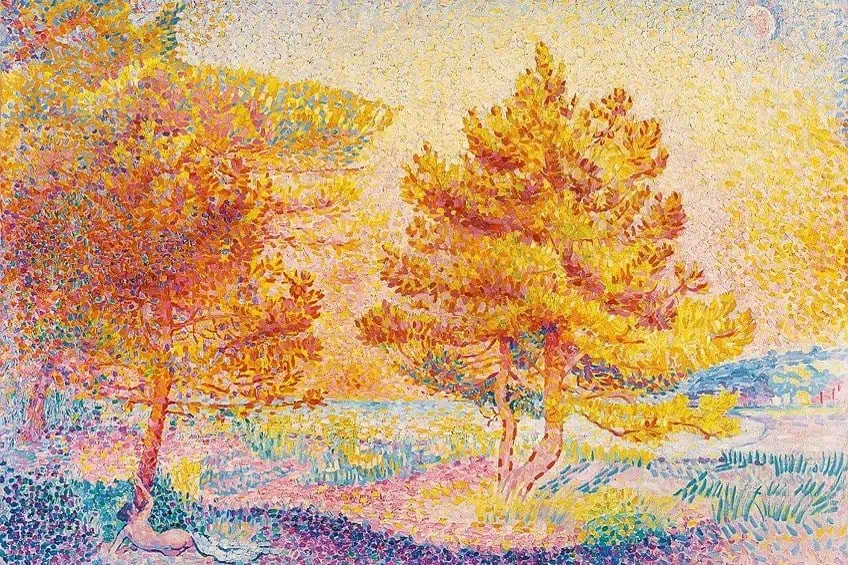Pointillism – Explore the Famous Dot Painting Technique
Following the birth of the Impressionist art era, a brand-new, awe-inspiring art movement came about, known as Pointillism. Two different names describe this technique of painting: Neo-Impressionism and Divisionism. The Pointillism movement came about in the 19th century all thanks to Pointillism artists Georges Seurat and Paul Signac. You may wonder what this era of art encompassed. Well, read on and delve deeper into what this movement was along with some of its great artists and artworks.
Contents
What Is Pointillism?
Pointillism art is a comprehensive painting technique that used the science behind optics and the way our eyes comprehend color from a distance when creating paintings. This entailed painting small, separate dots of unmixed color side by side. These dots were placed precariously in different shapes and patterns that, from afar, created a unique image. This effect was distinctive from what was done before, as it was almost an optical illusion.
The dots were placed meticulously and very close to one another so that from afar, it would blur the image into one seamless picture that the viewer would be seeing.

Pointillism was a reinvention of Impressionism and its use of small strokes of paint. Its reinvention was so intense that artists would go to the extent of creating entire paintings out of small individual dots of color. Because it emerged immediately after the Impressionist movement between the 1880s and 1890s, Pointillism is therefore seen as a component of the post-Impressionist movement. It is often wondered why one would go to the trouble of creating an entire painting with just dots, and this was because the Pointillism artists wanted to redefine art and what it stood for.
The new and unique movement was first rejected due to how different it was, but it continued and became quite the inspiring art movement for many.
Georges Seurat’s Early Career
The Impressionist movement was frequently regarded as rebellious and was quickly spreading through Paris in the early 1880s. In some of Seurat’s early work, we see his affinity for this new style with looser brushstrokes and lots of experimentation with the use of color.
By the year 1882, we see in his work the use of thick strokes of color in small patches that were blended to create a new look in texture.
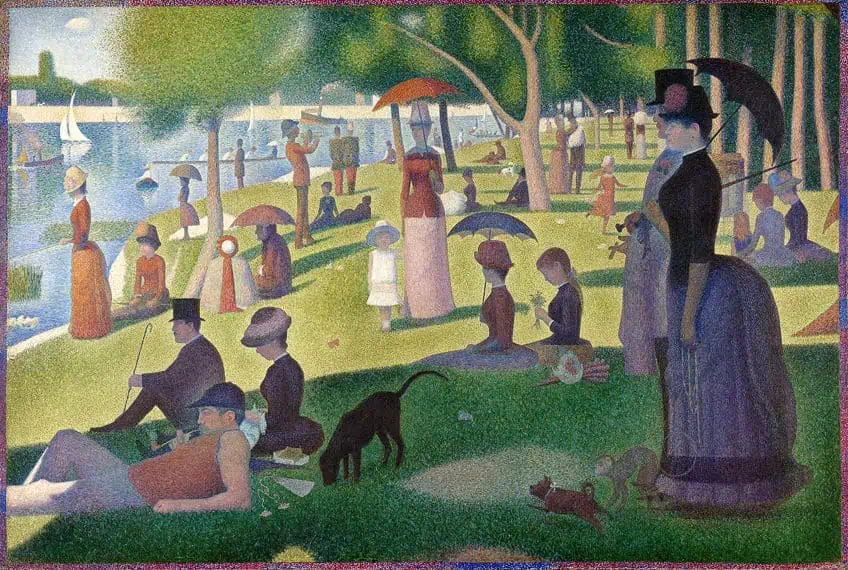
By 1884, he had completed his first major artwork, Bathers at Asnières (1884). The soft use of colors that we see in the Impressionist style was used in this large-scale painting created by Seurat. We also see the use of creating figures to look soft and sculptural in form as a distinct characteristic of this artist’s style of painting.
The painting was further rejected by the Salon in Paris due to its over-the-top and new approach.
The work was, however, displayed in the Groupe des Artistes Indépendants alongside other Impressionist works. He later ended up leaving the group and created his group with some of his affiliates such as Paul Signac and called it Société des Artistes Indépendants. Seurat is incredibly important to the history of Pointillism.
Who Invented Pointillism?
French artist Georges Seurat was born into a well-known family in Paris. He was a well-liked student at the Ecole des Beaux-Arts in Paris, where he received academic training. There, he learned from masters such as Ingres and Delacroix. In his 20s, he dedicated his time to learning the science behind color theory and, through a lengthy process of developing a new way of using color, this resulted in the era of art known as Pointillism. After the completion of his first artwork, he continued to make changes to the methods he used in painting.
Instead of blending his pigments together, he began to paint each of the colors onto the painting individually.
He focused on traditional- and conventional-styled paintings and further rejected Impressionism, which, was a painting technique whose goal was to make the most of color use based on the artist’s reaction to the piece of art they were making. He embraced a more scientific response and method to art that he developed during the year 1884 and named this style of painting Chromoluminarism.
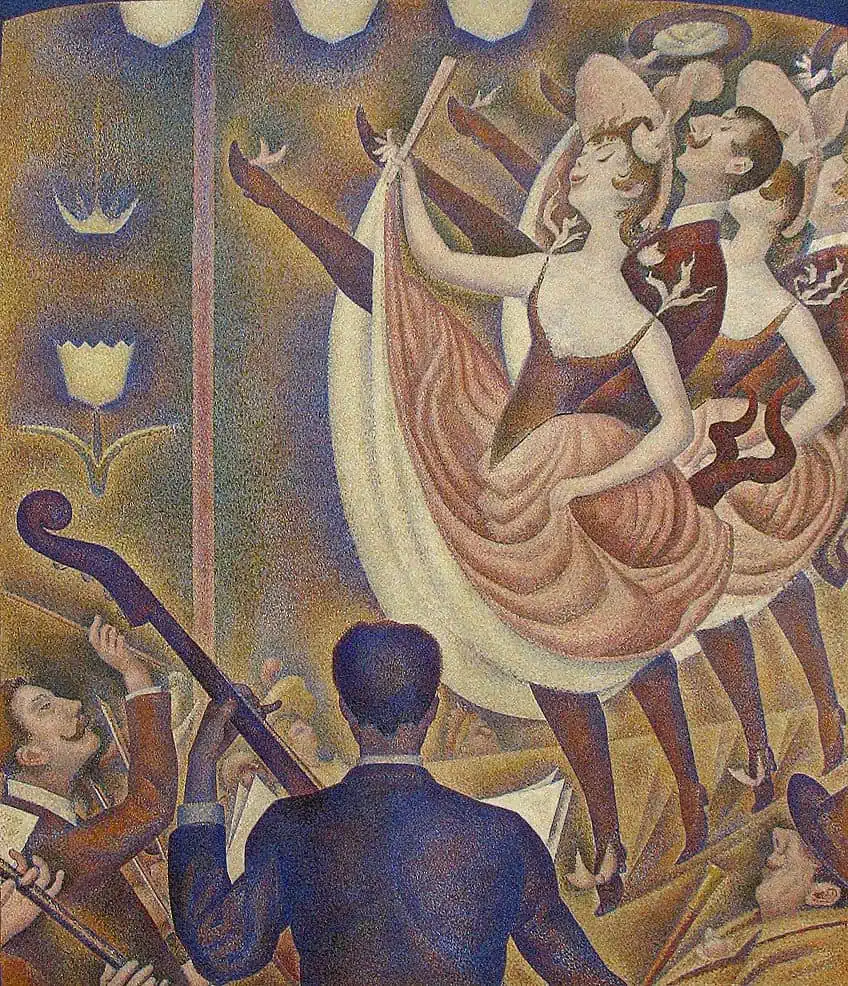
This approach was based on the scientific color theory developed by American physicist Ogden Rood and French chemist Michel Eugene Chevreul. This method was used scarcely by Impressionist painters and was only developed systematically by Seurat. The former Impressionist Paul Signac was Seurat’s main affiliate.
He was known for his coastal landscape paintings and strongly agreed with the scientific method behind the art movement of Pointillism and Divisionism, which, Seurat had developed.
Pointillism in Context
Pointillism art was predominately invented by Georges Seurat and Paul Signac, who were both French artists, in 1886. It was a response to the popular movement Impressionism and led to the development of a brand-new style of art. Pointillism was vastly different from prior art techniques developed amid the Impressionist movement as it focused on a scientific take with the use of color theory.
Impressionism was highly focused on the subjective opinion of the artist and Pointillism and its values did not agree with this.
Paul Signac rose to become a prominent artist in the Neo-Impressionist movement after Seurat’s death in 1891. Other pioneering members of the movement included Henri Edmond Cross and Maximilien Luce. Some different artists were also inspired to create Pointillism artworks include the likes of Vincent van Gogh and Pablo Picasso.
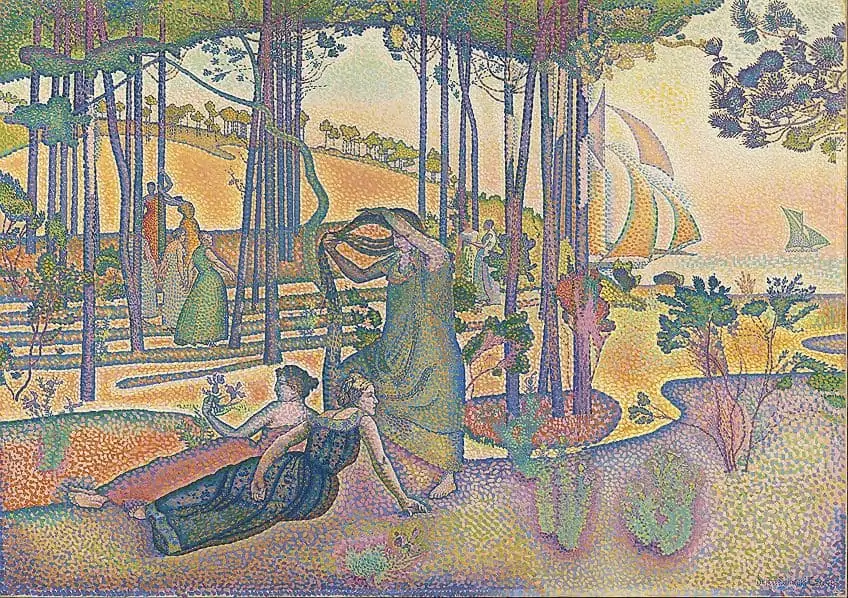
The name of the movement was first created by art critics to make fun of this ludicrous new technique of art. However, as the technique grew in popularity, Pointillism was made its official name and was seen as a well-respected style of art. This style was previously known as Divisionism, although, this name now belongs to a similar yet incredibly distinct style and technique of painting. Famous dot painting was also a name for Pointillism that some adopted. By arranging closely-spaced dots adjacent to one another, Pointillism, which emerged during the Neo-Impressionist era of art, sought to imitate the behavior of light and produce optical blending.
This technique resulted in the viewer seeing the image from afar through the dots blending rather than lots of tiny individual dots. This optical mixing approach produced a wider spectrum of hues that were both stronger and more vivid.
While Impressionist painters like Vincent van Gogh and Claude Monet frequently employed the use of small paint dabs and strokes, Pointillism developed this style even further. Pointillism was a reasonably simple art form to comprehend because all it involved was painting a canvas with tiny colored dots. Furthermore, founders Seurat and Signac gave the impression that their beautiful works’ style was relatively simple, but the method was quite difficult to master.
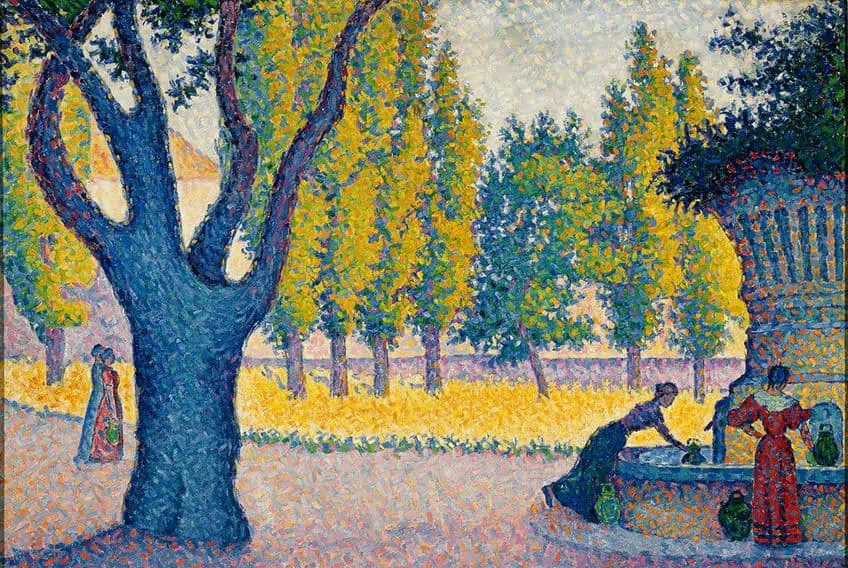
The use of tiny dots to simulate the impression of color and light in an image was known as Pointillism, and it was a very technical and scientific method of art creation. Due to this intricate process, artists who used it had to be very informed about where to arrange the tiny dots about the other colored dots so that the final image would be constructed correctly. As more and more artists began to use the well-known dotting paint method, it quickly emerged as the most innovative form of painting at the time. It was referred to as “dotted art” in a more casual setting.
Due to its innovative approach to color theory, Pointillism had a significant impact on a variety of emerging art movements. The style covered the latter half of the 19th and 20th centuries’ avant-garde periods.
The Pointillist method, though mostly associated with the post-Impressionist movement, also influenced the growth of Cubism and Pop art in the years that followed. Today’s current art trends show that a lot of artists continue to use this distinctive method in their work. Modern computer art and digital screen pixels both contain elements of Pointillism. However, Despite the apparent similarity in logic, Pointillism and pixel art have very diverse contexts and styles.
Understanding the Pointillism Technique
Pointillism, also known as famous dot painting to some, intensifies the use of optics to piece together a whole image from a variety of small, distinct dots. The hundreds of tiny colored dots that make up each image on the canvas are positioned in strategic proximity to one another.
The concepts underlying Pointillism are quite like how computer screens combine images using hundreds of pixels or how ink or toner is deposited in individual colors during printing.
In contrast to the use of watercolor paints, which were challenging to work with, for Pointillism, oils enabled the application of fine strokes of paint that would not bleed. Artists that used Pointillism frequently used unmixed, vivid, and intensely colored pigments. The employment of these intense hues would enable more vivid and varied colors to be combined by the eye from a distance while retaining a higher brilliance than when blended.
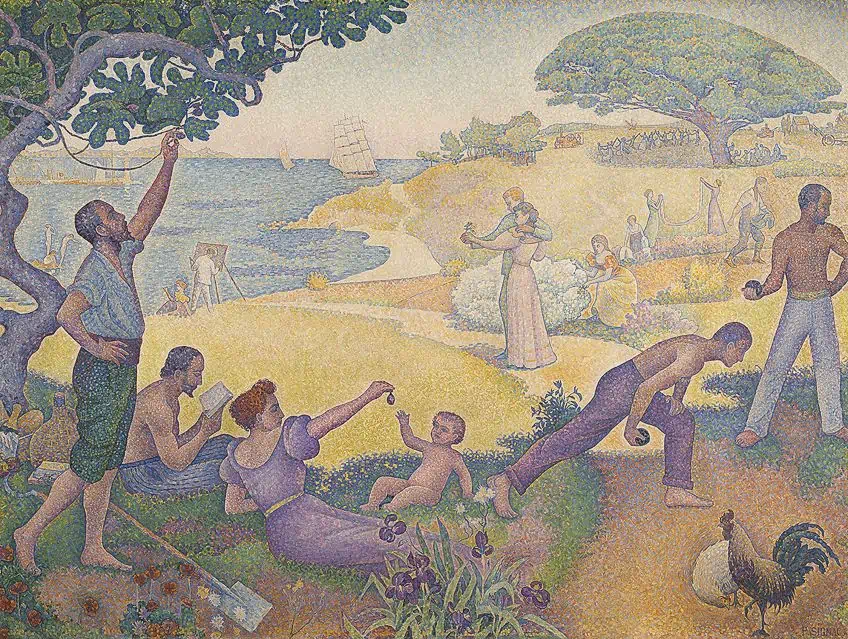
Most often, Pointillism paintings took a lot of planning and effort to complete since they required accuracy and a scientific understanding of how light behaves. While several paintings were praised for their technical skill and vivid colors, they were also said to lack the vitality that color mixing or broad brushstrokes provided.
Since it can be challenging to capture a scene with such a complicated technique, Pointillism paintings are still regularly criticized for being static and lacking a sense of movement. This reflects both the difficulties of creating the painting and the sensation of stagnation they frequently portray. However, painters like Signac and Van Gogh discovered new means of incorporating movement into their works using shapes and color.
Pointillism as a complicated technique was at first difficult to get right due to the fact that it made use of the way how eyes work with the brain.
Our brains automatically blend the thousands of dots together when we look at the painting from afar, thus creating a solid image. Pointillism is vaguely similar to and related to Divisionism as it is focused on color theory. Pointillism, however, is focused on the style of paint application as well as color theory. Pointillism is, therefore, a more technical variation of Divisionism.
The Eye and Pointillism Combined
One of the most rational approaches to artistic creation is Pointillism. The French scientist Michel Eugène Chevruel, who wrote a book, The Principles of Harmony and Contrast of Colors: and Their Applications to the Arts (1839) while looking for methods to make colors more vibrant for a Parisian tapestry company, was a significant contributor to the development of Pointillism.
Chevreul came to the conclusion that the tapestries’ visual impact depended on optics and the pairing of complementary hues, with the paintings created by Pointillism leaning heavily on these outcomes.
Unmixed and Unadulterated Color in Points
Pointillism involves the exact placement of paint in hundreds of thousands of distinct, unmixed dots. These dots are thoughtfully placed where the artist knows the viewer’s eye will perfectly mix them, resulting in a more stunning appearance. Because of this, artists seldom combine colors as doing so would make them seem less vibrant. Furthermore, the lines and clarity of the artwork tend to improve as the size of these dots decreases.

Conscientious Technique
The idea of optical illusion is the center of this extremely precise Neo-Impressionist method. Artists who practice pointillism eschew loose, impulsive brushstrokes in favor of a more precise, deliberate approach to painting. Before adding paint to a canvas, each Pointillism painting is carefully thought out so that painters can roughly predict how their work will turn out.
Most Pointillism artworks are created using oil paint since it is favored for its thickness and propensity to not run due to the technical nature of this method.
Pointillism and Music
Pointillism is frequently described using musical analogies, with the most obvious one being that the colored dots form a sort of melody. After Seurat passed away in 1891, Signac assumed the role of unofficial movement leadership. He compared the selection of his colors to the method of a composer selecting each instrument for a symphony.
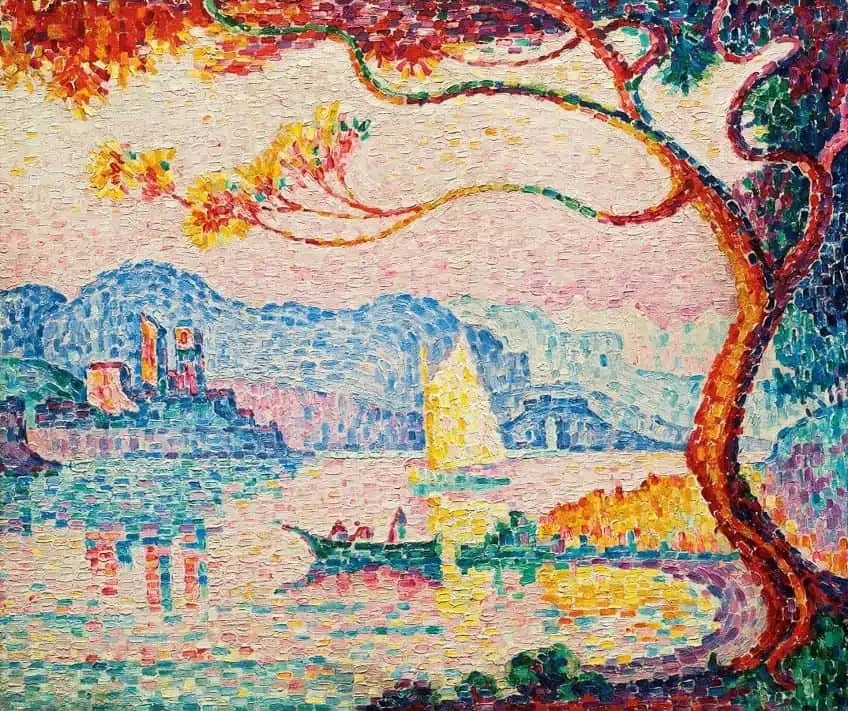
Characteristics of Pointillism
Impressionism served as the source of inspiration for Pointillism, which in turn gave rise to a novel style of painting in the realm of the arts. Reimagining portraits, landscapes, and seascapes in the manner of the Neo-Impressionist movement was a primary focus of the painting style.
Félix Fénéon, an art critic, initially coined the phrase “painting by dots” to explain and characterize this new and distinctive method of painting, which has since been known as Pointillism.
“Divisionism” or “Chromoluminarism” were the preferred names that Seurat had given this unique style of painting but “Pointillism” was what stuck for the name of the technique, which was derived from Fénéon’s expression. This method, used in Pointillism, which was distinguished by its application of unmixed colors directly to a canvas as opposed to mixing them first on a palette, was known as Pointillism.
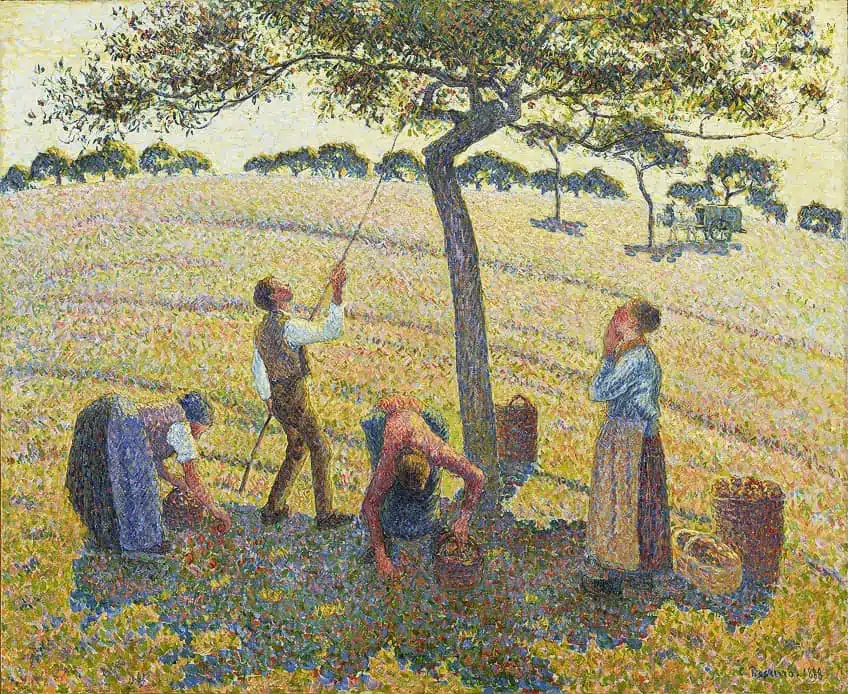
When left unmixed and pure, raw pigments can maintain their original bright hues, which is what Pointillism is all about. This technique of using unmixed pigment is what makes Pointillism so innovative and famous. Furthermore, round as well as square brushes can be used by painters to create a natural blend of the colors on the canvas when viewed by the human eye.
The saturation of the tones utilized, since colors were frequently bold and dazzling, is another hallmark of Pointillism.
To get these intense and potent hues, Pointillism artists use numerous variants of the same shade without blending pigments. In addition to producing these brilliant hues, they also assist in making canvases appear softer and less visually threatening. The art of Pointillism is said to have created the way for the growth of the Fauvist and Surrealist groups. Bright colors were employed in both movements.

The capacity to only be able to see the individual dots from a close distance to the canvas and be able to see the entire complete image from a distance is another key element of Pointillism that truly distinguishes it. In most cases, spectators naturally have to move a few steps back to observe the development of the painting as a whole due to the spotty touches of the paintbrush.
As a result, Pointillism paintings are distinguished by the distance they demand from spectators when seeing the finished product, as the farther, the observer is from the picture, the more “complete” it appears to be.
Pointillism vs. Divisionism: What Is the Difference?
Pointillism, throughout history, has been long and incorrectly associated with Divisionism. This was thought to be because Divisionism, also known as Chromoluminarism, came about around the same time as Pointillism and was associated with the post-Impressionism movement. The two techniques of Pointillism and Divisionism are similar in the way they approached their paintings by using brushstrokes and patterns to create a whole image; however, the final result of the Divisionism technique is far different from that of the Pointillism technique.
French art critic Charles Blanc devised a philosophy that encompassed scientific concepts and color theory, and this idea is what gave rise to and influenced Divisionism.
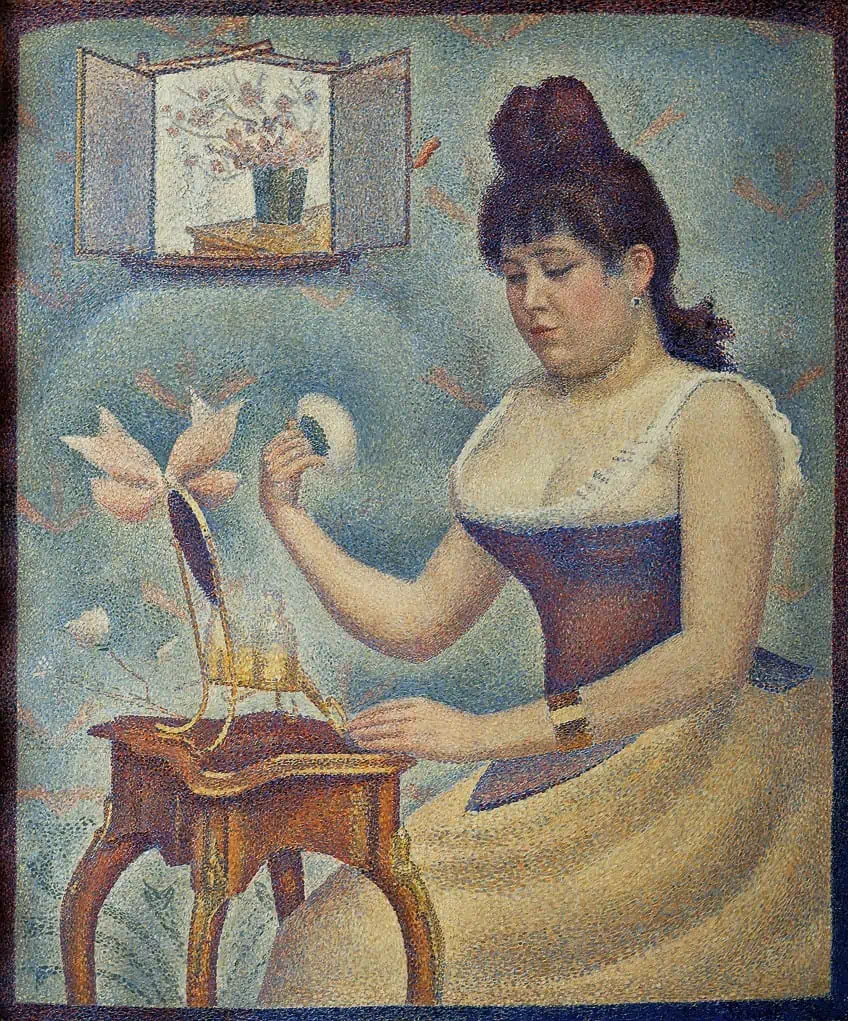
While Divisionism and its goal were centered on colors and how they could be separated, Pointillism was focused on the many possibilities and patterns of single-colored dots that could be assembled into a unified image when viewed from a distance. Only when the artwork was finished could one clearly distinguish between the two styles.
The brushstrokes are the primary difference between the finished products of these styles. Pointillism uses small brushstrokes in the form of colorful dots, while Divisionism uses larger, more cube-like brushstrokes.
In essence, it was believed that the same group of painters that created Pointillism also created Divisionism, which led to the association and confusion between the two movements. Van Gogh, Seurat, and Signac were all known to employ both methods in their works of art.
Pointillism, Dotted Art, and the Difference Between the Two
The techniques of Pointillism and Dotted art are extremely similar, and in the past, Pointillism was also referred to as “famous dot painting.” The context and manner in which the names of the techniques are used are the sole factors that set the two apart from one another.
Art historians and art collectors refer to the technique as Pointillism, giving it a more official label.

Dotted art is frequently used by the general public and is typically employed in less formal settings. The use of dotting and stippling in Aboriginal art, particularly in the well-known rock paintings, is a well-known example of dots in art. Dotted art is still used to describe amateur artists’ work today, nonetheless, as it carries less weight and expectation than the word “Pointillism art” would.
Famous Pointillism Artists and Their Paintings
There are hundreds of paintings that made use of the Pointillism technique, although few are notably famous. These famous Pointillism artworks, however, have become some of the most well-known and influential artworks today. In the following paragraphs, we will be going into detail about some of the greatest famous Pointillism artists and their famous paintings.
Camille Pissarro (1830 – 1903)
| Artist | Camille Pissarro |
| Birthdate | 10 July 1830 |
| Death Date | 13 November 1903 |
| Nationality | Danish and French |
Working in both the Impressionist and Neo-Impressionist traditions, Danish-French artist Camille Pissarro developed his technique for depicting daily life in his paintings. Pissarro chose to return to portrayals of common people in very realistic surroundings to explore new themes and techniques that would allow him to depart from the mainstream artistic style of his period. Pissarro first saw Paul Signac and Georges Seurat at this stage in their development of the Pointillist method.
Pissarro was one of the artists whose works significantly stood out among the Pointillist group and who easily accepted and applied Pointillism in his creations.
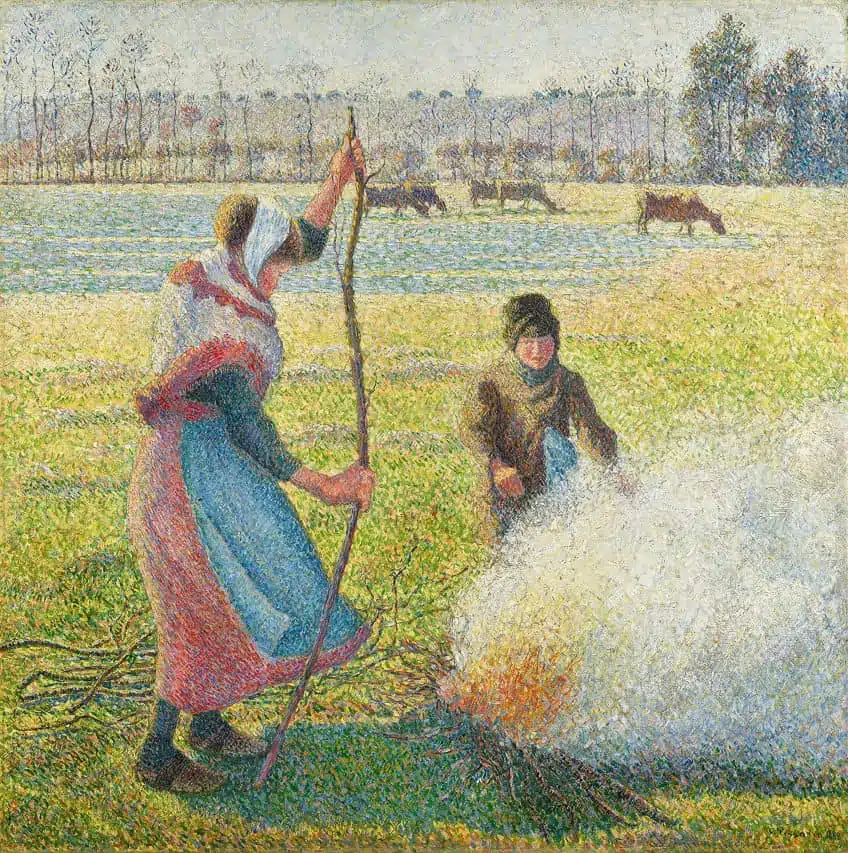
Gelée Blanche, Jeune Paysanne Faisant du Feu, one of his well-known Pointillism works, was created in the years 1887 and 1888. This painting, which is extremely large in scale, exemplifies how Pissarro was able to control the intricate subject of light. His representation of both heat and cold, where the lowering sun is seen to be creating shadows on the pastures and the leftover night frost, demonstrates his masterful understanding of the intricate relationships between light and the environment.
A little fog can also be seen emerging in the distance, which contrasts with the image’s feeble but shimmering light.
Pissarro was able to depict smoke, fire, and frigid air in this picture remarkably and subtly which could not be duplicated in other works of Pointillist art. Along with the skillful use of light that Pissarro made, his paintings are distinguished from others by his sympathetic treatment of the human situation.
Vincent van Gogh (1853 – 1890)
| Artist | Vincent van Gogh |
| Birthdate | 30 March 1853 |
| Death Date | 29 July 1890 |
| Nationality | Dutch |
Dutch painter Vincent van Gogh was known to play around and take part in the technical style of Pointillism for a short period. Van Gogh described his experience with Pointillism as a “revelation of color” after he visited Georges Seurat’s studio, which ultimately led him to begin his journey within the Pointillism technique. His palette of color became brighter and more filled with life.
However, it has been agreed by many art historians that the technical style of Pointillism was too serious for the likes of Van Gogh, who was free and unsettled and wanted his art to have no limitations.
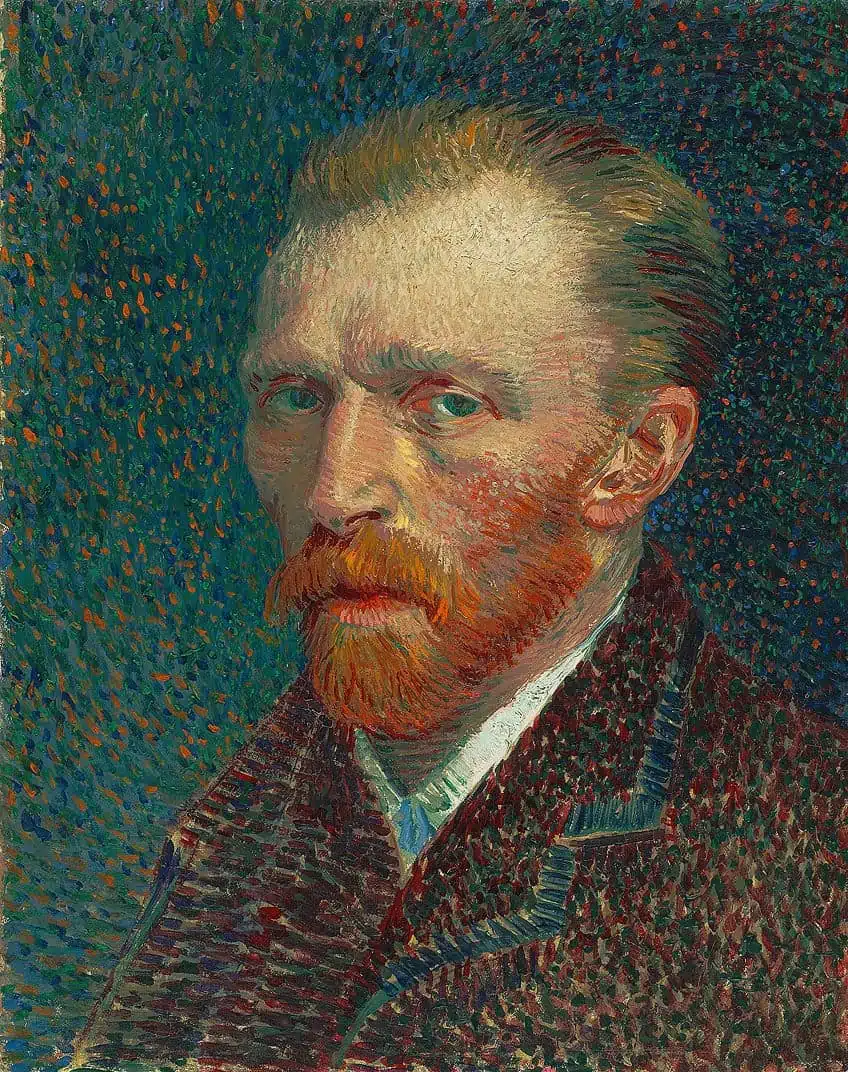
This led to him experimenting with this style for a short period before moving on back to his usual style of painting. In Van Gogh’s Self Portrait (1887), we see for the first time Van Gogh’s take on Pointillism painting. Self-Portrait’s surface sparkles with flecks of color in various shades of green, blue, orange, and red.
The juxtaposition between both the cool and warm hues produces a glittering appearance, giving the impression that there is constant movement in van Gogh’s background.
Van Gogh’s deep green eyes appear to express a great passion that serves as another main point in the painting. Spectators cannot help but become engrossed in the rhythm established by the sudden and disjointed dabs of paint. Van Gogh learned how to depict the mobility of light from his friend and fellow artist Camille Pissarro, and he displayed tremendous aptitude in doing so. Van Gogh moved in temporarily as Pissarro’s renter, and during their time together, Pissarro taught him several techniques for locating and interpreting light and color, a skill that can be seen in his Self Portrait.
Charles Angrand (1854 – 1926)
| Artist | Charles Angrand |
| Birthdate | 19 April 1854 |
| Death Date | 1 April 1926 |
| Nationality | French |
Charles Angrand was a famous artist who gained popularity through his Neo-Impressionist and known as Pointillist paintings and drawings. The paintings that he created during the early 1880s were of the Impressionist style and depicted rural subjects with messy and tapered brushstrokes with light-filled coloration. This work of Angrand was influenced by the likes of Claude Monet, Camille Pissarro, and Jules Bastien-Lepage.
During the mid-1880s, he began to interact with Pointillism pioneers Seurat and Signac, and through these interactions, he began to lean more toward the Neo-Impressionist style.
From the year 1887, his paintings and drawings fully became Neo-Impressionist-based including Seurat’s tenebrism style. Angrand’s style of Pointillism painting was different from the movement’s pioneers’ styles because his color palette was more muted and duller, which was completely different from the bright contrasting colors used by Seurat and Signac. He believed that the muted theme of his paintings allowed a better capturing of the depictions of how the light was displayed in his artworks.
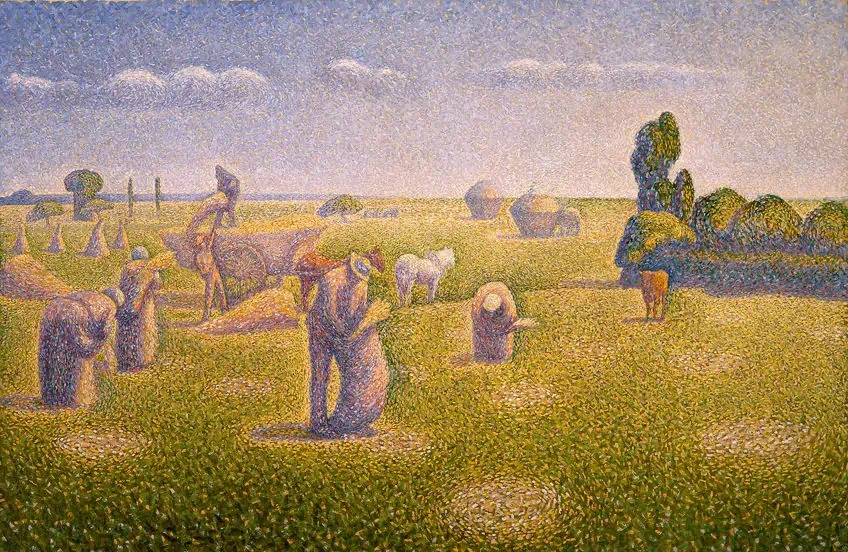
In his artwork Couple on the Street (1887), Angrand used dots in varying dull shades such as gray placed closely together to create an illusion and enhance shadows. He avoided a bright and colorful color palette in this painting completely, which we see in many other Pointillism artists’ paintings. Another notable Pointillism painting by Angrand is The Harvesters (1892). This painting differs from his usual subdued color palette, instead deciding to mimic the bright colors used by Seurat and Signac.
This is one of his more playful and colorful artworks. The usage of warm tones on the fieldworkers serves as an example of how color is used.
In addition to this, bright color is also used to depict a wash of warm light flooding over the workers in the field. The use of contrasting colors with the warm tones of the workers and the cool tones in the background displays how perceptive of light and shading Angrand truly was.
Henri-Edmond Cross (1856 – 1910)
| Artist | Henri-Edmond Cross |
| Birthdate | 20 May 1856 |
| Death Date | 16 May 1910 |
| Nationality | French |
Henri-Edmond Cross, one of the leading Neo-Impressionists, created a wide range of works in his final two decades, which were crucial to the growth of early 20th-century Modernist painting. Cross met other painters who shared his views when he co-founded the Société des Artistes Indépendants in 1884. Among this group were Pointillism artists Georges Seurat and Charles Angrand.
He was immediately drawn to Impressionism and then Realism, before adopting the Pointillist style developed by his friend and the head of the Neo-Impressionists, Georges Seurat.
Cross developed a close connection with these artists but didn’t start painting in the Pointillist style until 1891. He finished his initial Pointillism work within the same year, Madame Hector France, which contained an image of his new bride. Irma Clare, who at the time was married to the author Hector France, is featured in this enormous, full-length picture, which has a perfect balance of light and shadow.

The white hydrangea in the center and the shimmering lamps in the distance both represent light, which is reminiscent of a summer night. These areas of illumination are further contrasted by the dark shades used to depict Madame France’s gown and the bright shadow that covers her face.
Cross was able to suggest depth and space in this image by angling the chair and making use of the geometric patterns on the floor.
It has been claimed that Cross’ paintings were more Divisionist in style, even though they made use of Pointillism’s methods. This was because this portrait has a grainy yet ambient glow about it, which may indicate that the color division was given more attention than the dot patterns.
Maximilien Luce (1858 – 1941)
| Artist | Maximilien Luce |
| Birthdate | 13 March 1858 |
| Death Date | 6 February 1941 |
| Nationality | French |
French Neo-Impressionist artist Maximilien Luce specialized in paintings, illustrations, engravings, and graphic art. He began his journey as an engraver, and then went on to painting, first as an Impressionist and then as a Pointillist painter. In 1884, he was introduced to the Divisionist technique pioneered by Georges Seurat. This is what influenced Luce to opt for the Pointillist technique.
Luce began to create paintings that were intense depictions of contemporary subjects, showcasing the “violent effects of light.”
In 1887, he relocated to Montmarte, where he joined the Société des Artistes Indépendants and took part in their spring exhibition. Paul Signac bought one of his paintings, La Toilette (1872). One of Luce’s most famous Pointillist paintings is Morning, Interior, which was painted in 1890. The painting depicts a man who is getting ready for a day at work early in the morning. It is said, Gustave Perrot, a close friend of Luce and a Neo-Impressionist painter, is the individual represented in the artwork.

In Morning, Interior, we see a youthful man putting on his left shoe whilst sitting on a small and delicate bed. The room is scarcely decorated, however, what makes up for the lack of furnishings is the sunlight of the morning cascading delicately into the room through the windows, which is what the viewer would immediately focus on.
Luce managed to perfectly depict the light streaming into the room by using dots of yellow, orange, and red. This creates a bright and lively depiction of warmth and comfort that is given by the light.
The light is further emphasized through the use of complementary colors of cooler tones such as light blue and violet. The use of contrasting colors in the painting help to differentiate the streaming light throughout the room. This can be demonstrated by the colors that are used on the furnishes such as the vase or bedclothes. This delicate showcase of light gives the viewer an intimate view of the subject going about his morning habits. The painting consists of a stippling technique, which showcases Luce’s influence from the unique Pointillist style.
Paul Signac (1863 – 1935)
| Artist | Paul Signac |
| Birthdate | 11 November 1863 |
| Death Date | 15 August 1935 |
| Nationality | French |
Paul Victor Jules Signac, a French Neo-Impressionist painter, co-founded the Pointillist movement with Georges Seurat. Under the influence of Seurat, he disregarded the short brushstrokes of Impressionism and adopted the unique style of Pointillism, which intended not to blend on the canvas but to blend naturally in the eye. A large portion of Signac’s paintings were of the French coast.
After Seurat’s death, Signac took up the role as the main pioneer of Pointillism and continued to work with the unique style throughout his life.
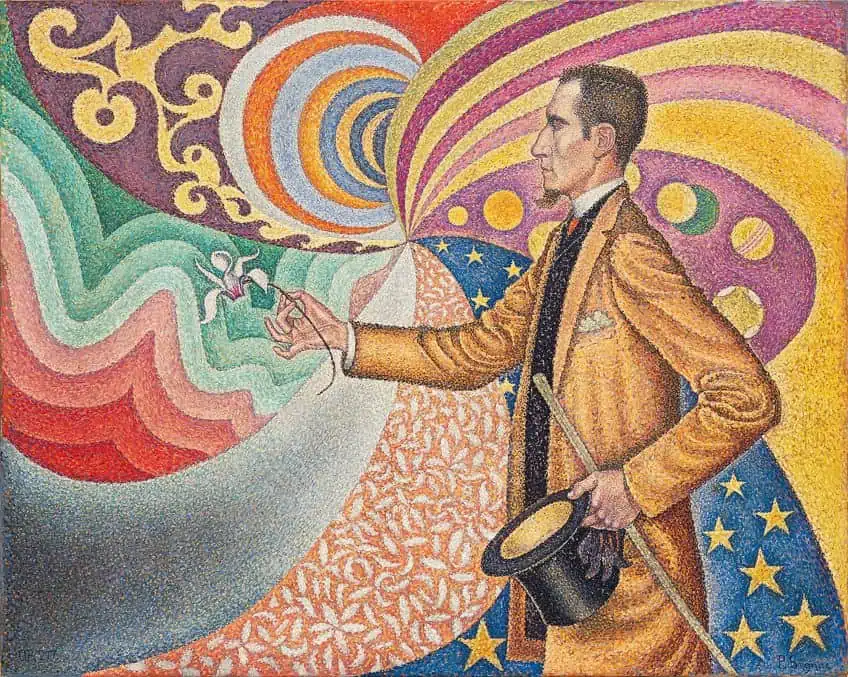
One of Signac’s most famous works of art is known as Opus 217. Against the Enamel of a Background Rhythmic with Beats and Angles, Tones, and Tints, Portrait of M. Félix Fénéon, which was painted in 1890. The painting was a tribute to his dear friend Félix Fénéon as a portrait that has since become of Signac’s most memorable artworks. The painting depicts Signac’s love for using bright and outstanding colors.
Signac’s impressive talent for Pointillism is depicted within the color wheel in the background, which creates a complicated image to blend optically.
Movement is created within the painting through the use of the Pointillist technique, as the dots of color seem to be “dancing” next to each other. Signac managed to beautifully demonstrate Pointillism through the vivid colors and angles created in this painting. Both components added to the intensity of the painting and it almost seems to be moving.
Pointillism was and continues to be a bright and influential art technique that paved the way for many artists’ careers. Pointillism was a revolutionary art technique that was rejected at first but was soon adored and aspired towards. The artworks from this time period have gone on to become some of the most well-known and influential works of art ever created. If you enjoyed this article, we encourage you to research further on the topic.
Take a look at our Pointillism art webstory here!
Frequently Asked Questions
What Is Seurat Pointillism?
Georges Seurat was a French painter and founder of the 19th-century Neo-Impressionism art technique, which entailed the portrayal of light through the use of tiny dots of paint and contrasting colors. This became known as Pointillism or Seurat Pointillism.
What Is Pointillism and Its Style?
Pointillism is a term that describes the technique of placing thousands of individual dots onto a canvas to create a complete image with a maximum brightness of color and hues. This technique of painting relies on optical mixing for the image to be viewed as a whole.
What Are the Benefits of Pointillism?
One of the many benefits of the Pointillism technique is that more vivid and purer colors could be used in a painting due to the fact that the colors are not mixed, which would lead to the vibrancy of the colors being lost.
Jordan Anthony is a Cape Town-based film photographer, curator, and arts writer. She holds a Bachelor of Art in Fine Arts from the University of the Witwatersrand, Johannesburg, where she explored themes like healing, identity, dreams, and intuitive creation in her Contemporary art practice. Jordan has collaborated with various local art institutions, including the KZNSA Gallery in Durban, the Turbine Art Fair, and the Wits Art Museum. Her photography focuses on abstract color manipulations, portraiture, candid shots, and urban landscapes. She’s intrigued by philosophy, memory, and esotericism, drawing inspiration from Surrealism, Fluxus, and ancient civilizations, as well as childhood influences and found objects. Jordan is working for artfilemagazine since 2022 and writes blog posts about art history and photography.
Learn more about Jordan Anthony and about us.
Cite this Article
Jordan, Anthony, “Pointillism – Explore the Famous Dot Painting Technique.” artfilemagazine – Your Online Art Source. September 20, 2022. URL: https://artfilemagazine.com/pointillism/
Anthony, J. (2022, 20 September). Pointillism – Explore the Famous Dot Painting Technique. artfilemagazine – Your Online Art Source. https://artfilemagazine.com/pointillism/
Anthony, Jordan. “Pointillism – Explore the Famous Dot Painting Technique.” artfilemagazine – Your Online Art Source, September 20, 2022. https://artfilemagazine.com/pointillism/.


